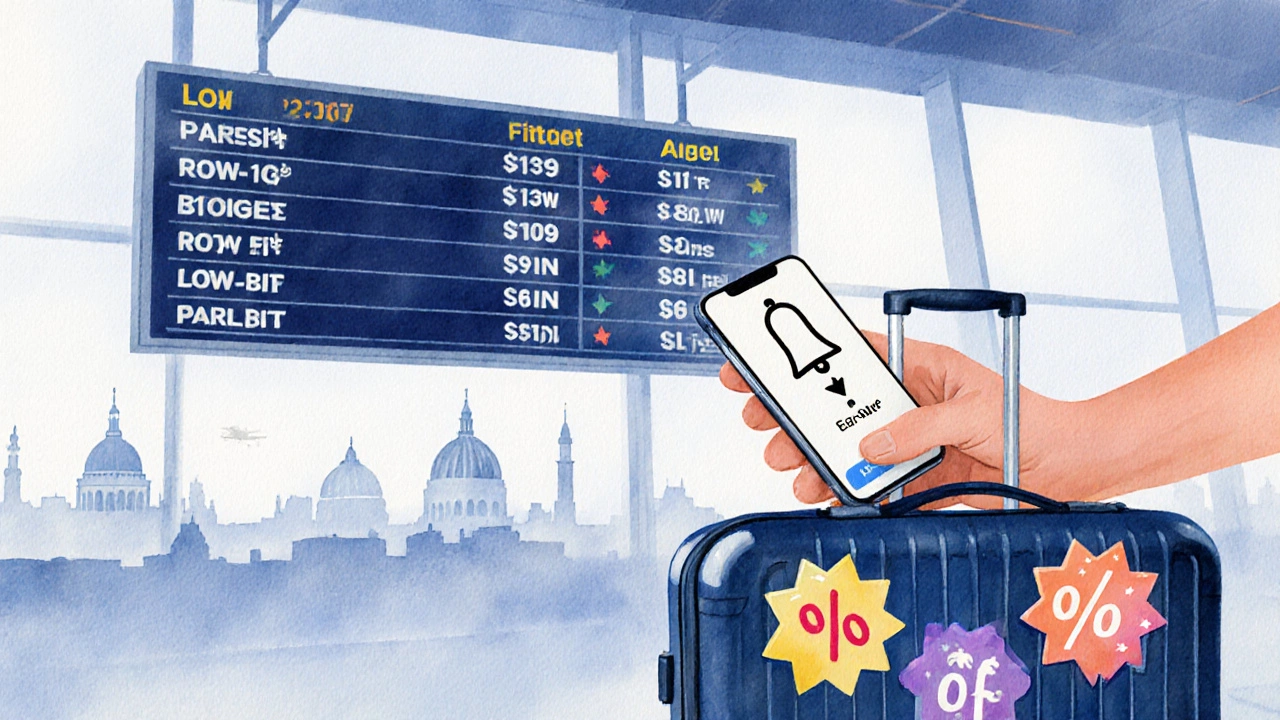City Break Savings Calculator
Find Your Best Travel Month
Based on European travel data, January and February are typically the cheapest months for city breaks, with airfare up to 45% cheaper and hotels up to 30% lower than peak season. Find out how much you could save by traveling during the low season.
Best month for your travel:
Estimated savings:
Key Takeaways
- The cheapest month for a city break in most European destinations is usually January or February, when demand is at its lowest.
- Airfare drops by up to 45% and hotel rates can be 30% cheaper during the low‑season shoulder months.
- Booking 8-12 weeks ahead and using price‑alert tools maximises savings.
- Avoid major festivals and school holidays, even if they fall in a traditionally cheap month.
- Flexibility on travel dates and destination gives you the biggest price advantage.
Planning a short escape doesn’t have to break the bank. If you can pinpoint the cheapest month for a city break, you’ll save on flights, hotels and even meals. Below we break down exactly why certain months are cheaper, how to read the data, and practical steps to lock in the best price for your next urban adventure.
What a "city break" Really Means
When planning a quick getaway, city break is a short, typically weekend‑length trip to a major urban destination. The appeal is easy: you get culture, dining, nightlife and sightseeing without a week‑long commitment. Because the stay is brief, every pound counts - especially on transport and lodging.
How Seasons Shape Prices
Travel pricing follows a simple rule: demand drives cost. In the tourism world this creates three pricing zones:
- High season - summer months (June‑August) and major holidays when business and leisure travel surge.
- Low season - winter months (January‑February) in most of Europe, when both business conferences and school trips dip.
- Shoulder season - the transitional periods (March‑May and September‑October) that often blend lower demand with milder weather.
Because a city break is usually only a few nights, airlines and hotels treat it like any other short‑stay booking: they fill empty seats and rooms aggressively during the low and shoulder periods. That’s why the cheapest month almost always falls in the low‑season window.
Data Sources That Reveal the Cheapest Month
To turn intuition into fact, we rely on three trusted data sets:
- Skyscanner Price Index - aggregates millions of flight searches and shows monthly price averages for major city routes.
- Eurostat Tourism Statistics - provides occupancy rates and average daily rates (ADR) for hotels across EU cities.
- Travel Price Index (TPI) - a composite metric that blends airfare, hotel and local transport costs.
Cross‑referencing these sources gives a reliable picture of when trips are cheapest.

Month‑by‑Month Cost Breakdown (Europe)
| Month | Airfare (vs. peak) | Hotel ADR (vs. peak) | Combined TPI | Typical Weather |
|---|---|---|---|---|
| January | -45% | -30% | 0.55 | Cold, off‑peak |
| February | -40% | -28% | 0.58 | Cold, still off‑peak |
| March | -30% | -20% | 0.68 | Early spring |
| April | -25% | -15% | 0.73 | Spring, mild |
| May | -15% | -10% | 0.82 | Warm, busy |
| June | +5% | +10% | 1.10 | Summer, peak |
| July | +10% | +15% | 1.20 | Summer, peak |
| August | +8% | +12% | 1.18 | Summer, peak |
| September | -10% | -8% | 0.88 | Late summer |
| October | -20% | -15% | 0.70 | Autumn, mild |
| November | -30% | -25% | 0.60 | Cool, pre‑holiday |
| December | -10% | -5% | 0.85 | Holiday season |
The table shows that January and February consistently deliver the lowest combined price index, followed closely by November and the autumn shoulder months. While the weather can be chilly, most European capitals still offer indoor attractions, festivals and lower crowds.
Why January and February Win
Two factors drive the deep discounts during these months:
- Business travel lull - after the year‑end rush, many companies scale back trips, leaving seats and rooms idle.
- Tourist demand drop - schools are on break, but families often opt for warmer destinations, leaving city break demand thin.
Airlines respond by launching “flash sales”, and hotels use dynamic pricing engines to fill occupancy, often offering 30‑40% off their standard rates.
How to Lock In the Cheapest Month
Knowing the best month is only half the battle. Here’s a step‑by‑step plan to maximise savings:
- Set price alerts on Skyscanner, Google Flights or Kayak. These services email you when the fare for your chosen route drops below a threshold.
- Book 8-12 weeks ahead. Data from the Travel Price Index shows that this window hits the sweet spot between last‑minute hikes and early‑bird mark‑ups.
- Stay flexible on dates. Shifting your departure by just one or two days can shave 10‑15% off the total.
- Consider nearby airports. For example, flying into Brussels instead of Amsterdam for a Dutch city break can cut airfare by up to 20%.
- Use loyalty points or credit‑card travel portals. Many cards offer bonus points for purchases made in the low‑season window.
Combine these tactics and you’ll often end up paying less than half of what you’d spend during the summer high season.

Pro Tips and Common Pitfalls
Pro tip: Check local event calendars. Even a low‑season month can spike prices if a major conference or festival (e.g., Berlin Fashion Week in January) is scheduled.
Pitfall #1: Ignoring weather. While indoor museums are great, some city experiences-like rooftop bars or outdoor markets-are limited in deep winter. Balance cost with enjoyment.
Pitfall #2: Forgetting extra fees. Low‑cost airlines often add baggage, seat selection and airport‑transfer fees that can erode the discount. Add those costs into your spreadsheet before you book.
Pitfall #3: Over‑relying on “last‑minute deals”. In January the market is thin; waiting too long can mean no seats at all.
Case Study: London to Budapest in February
A traveler from London wanted a 2‑night city break in Budapest. By setting a Skyscanner alert in early December, they caught a €45 return flight on a low‑cost carrier. Hotel prices for a centrally‑located 3‑star property averaged €55 per night in February, versus €95 in May. Total cost: €145, including a €20 public transport pass. The same trip in June would have been around €300.
This real‑world example shows how aligning with the cheapest month can halve the budget, leaving extra money for dining or a guided tour.
Quick Checklist Before You Book
- Confirm the month falls in the low‑season or shoulder period for your chosen city.
- Run price alerts for both flights and hotels.
- Look up local event calendars to avoid surprise price spikes.
- Calculate total cost including taxes, baggage fees and city‑pass tickets.
- Book 8‑12 weeks ahead, but no earlier than 20 weeks to avoid early‑bird premiums.
Frequently Asked Questions
Is January always the cheapest month for every city?
Almost all major European capitals see the lowest travel costs in January, but exceptions exist. Southern Mediterranean cities like Barcelona can stay relatively pricey due to milder weather attracting winter sun seekers.
Can I still enjoy outdoor attractions in a winter city break?
Yes. Many cities offer indoor‑warm alternatives (museums, historic buildings) and winter festivals. For outdoor activities, dress warmly and pick destinations with milder February climates, like Lisbon or Rome.
How far in advance should I set price alerts?
Start alerts 12 weeks before your intended departure. This gives the algorithm time to detect price dips and you enough window to act.
Do low‑season hotel deals include breakfast?
Many budget‑friendly offers do include a continental breakfast. Always read the fine print; some “room‑only” rates skip meals, while “full‑board” promotions are rare in winter.
Is travel insurance necessary for a cheap city break?
It’s wise to have basic coverage for flight cancellations or medical emergencies, even on a budget trip. Some credit cards already include it when you book through them.
By focusing on the cheapest month, using data‑driven alerts and staying flexible, you can turn a city break into a budget‑friendly highlight of the year. Happy travels!
